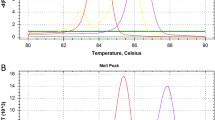Abstract
A loop-mediated isothermal amplification (LAMP)-based method has been developed for the analysis of animal feed for the presence of Salmonella spp. The method is compatible with the standard culture-based method ISO 6579:2002. Samples comprising 100 g feed are pre-enriched in 900 ml buffered peptone water, and then 2× 100-μl aliquots are taken, one for secondary enrichment in a LAMP-friendly broth and the other for secondary enrichment according to ISO 6579:2002. A 3-μl aliquot of the LAMP-friendly culture is added directly into a LAMP reaction. LAMP-positive signals are considered presumptive of the presence of Salmonella spp.; confirmation is obtained by continuation of ISO 6579:2002. Negative LAMP reactions can be considered as signifying that the sample does not contain viable Salmonella. The LAMP assay incorporates an internal amplification control (IAC); the target and IAC signals are distinguished by the difference in annealing temperatures of the amplicons. The method provides simple and reliable screening of feedstuffs for Salmonella spp., with uncontaminated samples being identified in 24 h less than using the current ISO standard method alone. The method was used to analyse 79 samples of animal feed and identified 13 Salmonella-positive samples.





Similar content being viewed by others
Notes
This IAC approach will not be applicable if using turbidity as an end-point detection system (Chen et al. 2011; Soli et al. 2013). However, users of turbidity-based detection should recognise its limitations and the potential ambiguity of its results; in that, false-negative result interpretation cannot be totally avoided.
References
Chen S, Wang F, Beaulieu JC, Stein RE, Ge B (2011) Rapid detection of viable salmonellae in produce by coupling propidium monoazide with loop-mediated isothermal amplification. Appl Environ Microbiol 77:4008–4016
Cook N, de Ridder GA, D’Agostino M, Taylor MB (2012) Internal amplification controls in real-time polymerase chain reaction-based methods for pathogen detection. In: Rodriguez-Lazaro, D. (ed.) Real-time PCR in food science: current technology and applications. Caister Academic, pp. 35–41
D’Agostino M, Rodriguez-Lazaro D (2009) Harmonisation and validation of methods in food safety—“FOOD-PCR”, a case study. In: G. Barbosa-Canovas, G. Mortimer A, Colonna P, Lineback D, Spiess W, Buckle K (eds.) Global issues in food safety and technology. Academic, pp. 199–209
D’Agostino M, Wagner M, Vazquez-Boland JA, Kuchta T, Karpiskova R, Hoorfar J, Novella S, Scortti M, Ellison J, Murray A, Fernandes I, Kuhn M, Pazlarova J, Heuvelink A, Cook N (2004) A validated PCR-Based method to detect Listeria monocytogenes using raw milk as a food model—towards an international standard. J Food Prot 67:1646–55
D’Agostino M, Cook N, Rodriguez-Lazaro D, Rutjes S (2011) Nucleic acid amplification-based methods for detection of enteric viruses: definition of controls and interpretation of results. Food Environ Virol 3(2):55–60
Foley SL, Lynne AM, Nayak R (2008) Salmonella challenges: prevalence in swine and poultry and potential pathogenicity of such isolates. J Anim Sci 86(14 Suppl):E149–62
Hara-Kudo Y, Yoshino M, Kojima T, Ikedo M (2005) Loop-mediated isothermal amplification for the rapid detection of Salmonella. FEMS Microbiol Lett 253:155–161
International Organisation for Standardization (2002) ISO 6579:2002—microbiology of food and animal feeding stuffs—horizontal method for the detection of Salmonella spp.
Jones FT (2011) A review of practical Salmonella control measures in animal feed. J Appl Poult Res 20:102–113
Knutsson R, Fontanesi M, Grage H, Radstrom P (2002) Development of a PCR-compatible enrichment medium for Yersinia enterocolitica: amplification precision and dynamic detection range during cultivation. Int J Food Microbiol 72:185–201
Kokkinos PA, Ziros PG, Bellou M, Vantarakis A (2014) Loop-mediated isothermal amplification (LAMP) for the detection of Salmonella in food. Food Anal Methods 7:512–526
Li X, Bethune LA, Jia Y, Lovell RA, Proescholdt TA, Benz SA, Schell TC, Kaplan G, McChesney DG (2012) Surveillance of Salmonella prevalence in animal feeds and characterization of the Salmonella isolates by serotyping and antimicrobial susceptibility. Foodborne Pathog Dis 9:692–8
Papadopoulou C, Carrique-Mas JJ, Davies RH, Sayers AR (2009) Retrospective analysis of Salmonella isolates recovered from animal feed in Great Britain. Vet Rec 165:681–8
Rodríguez-Lázaro D, D’Agostino M, Pla M, Cook N (2004) Construction strategy for an internal amplification control for real-time diagnostic assays using nucleic acid sequence-based amplification: development and clinical application. J Clin Microbiol 42:5832–6
Rodríguez-Lázaro D, Lombard B, Smith H, Rzezutka A, D’Agostino M, Helmuth R, Schroeter A, Malorney B, Miko A, Guerra B, Davison J, Koblinsky A, Hernández M, Bertheau Y, Cook N (2007) Trends in analytical methodology in food safety and quality: monitoring microorganisms and genetically modified organisms. Trends Food Sci Technol 18:306–319
Soli KW, Kas M, Maure T, Umezaki M, Morita A, Siba PM, Greenhill AR, Horwood PF (2013) Evaluation of colorimetric detection methods for Shigella, Salmonella, and Vibrio cholerae by loop-mediated isothermal amplification. Diagn Microbiol Infect Dis 77:321–3
Acknowledgments
The research leading to these results has received funding from the European Union Seventh Framework Programme (FP7/2007‐2013) under grant agreement no. 265702. MD-V was supported by a grant from the Spanish Ministry. MD and NC were supported by a grant Q-SAFFE. We thank Q-SAFFE project partners, particularly John Thompson and Sons Ltd., for the supply of feed samples. We thank Almudena Perez and Zohartze Monteagudo for their technical assistance.
Conflict of Interest
Marta Diez-Valcarce has no conflict of interest. Nigel Cook has no conflict of interest. Martin D’Agostino has no conflict of interest. Susana Robles has no conflict of interest. Begoña Losilla-Garcia has no conflict of interest. This article does not contain any studies with human or animal subjects.
Author information
Authors and Affiliations
Corresponding author
Rights and permissions
About this article
Cite this article
D’Agostino, M., Diez-Valcarce, M., Robles, S. et al. A Loop-Mediated Isothermal Amplification-Based Method for Analysing Animal Feed for the Presence of Salmonella . Food Anal. Methods 8, 2409–2416 (2015). https://doi.org/10.1007/s12161-015-0148-0
Received:
Accepted:
Published:
Issue Date:
DOI: https://doi.org/10.1007/s12161-015-0148-0




